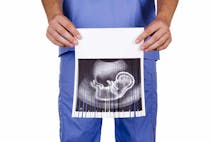
University of Michigan slammed for honoring Jack Kevorkian
Cassy Cooke
·
Guest Column·By Dr. Ingrid Skop
Legalized abortion doesn’t protect a woman from maternal mortality. It does the opposite.
Disclaimer: The opinions expressed in this guest post are solely those of the author and are not necessarily reflective of Live Action or Live Action News.
“Maternal mortality is increasing in the United States.”
“Abortion is safer than childbirth.”
“Legal abortion must remain readily available so women can end their pregnancies safely.”
Have you ever heard a variation of these arguments? No obstetrician has ever greeted an excited newly pregnant patient with these words. This argument is usually only voiced to convince an undecided poor or minority woman to choose an abortion.
Statistics on maternal mortality are widely known to be flawed and incomplete. A recent study documented an apparent dramatic increase in U.S. maternal deaths, and this has been widely reported. Subsequent individual state maternal mortality committee reviews have determined that improved detection of deaths and recording errors on death certificates have artificially caused much of the increase. The CDC does not work proactively to discover maternal deaths, but merely records those that come to its attention, usually through death certificate documentation.
Vocal abortion advocate and former CDC Abortion Surveillance Division chairman, Dr. David Grimes, was well aware of these limitations, but nonetheless published an article concluding that abortion is 14 times safer than childbirth. Misleadingly, he compared abortion-related deaths to the numbers of legal abortions (abortion mortality rate), whereas maternal deaths were compared to 100,000 live births (maternal mortality ratio). A comparison is not valid if it uses different denominators. Additionally, of the four numbers, only the number of live births is accurately known, due to mandated birth certificates. Yet, only two-thirds of maternal deaths are related to live birth. Maternal deaths may be separated from the end of pregnancy by up to a year, and mental health-related deaths are particularly difficult to correlate to the pregnancy event that initiated them.
READ: NBC helps spread false idea that pro-life laws increase maternal mortality
Abortion numbers, complications, and deaths are voluntarily reported and incomplete. In 2014, the CDC recorded 652,639 abortions, whereas the Guttmacher Institute reported 926,000. Only 28 states require abortionists to report complications and only 12 states require other physicians to report abortion complications. There are no penalties for non-compliance.
It is estimated that 50% of maternal deaths are not reported as such on death certificates, and the number is undoubtedly much higher for deaths related to abortion. European records-linkage studies documented that 94% of abortion-related deaths were not reported as such on death certificates, and also found that a woman is far more likely to remain alive a year after delivery of a child than after an abortion. Due to legal or ideological motivations, search engine failure to obtain abortion-specific codes, and the failure of many abortionists to maintain hospital admitting privileges or care for their complications, it is likely that most U.S. abortion-related maternal deaths are not reported to the CDC for investigation.
There are multiple ways an abortion may cause a woman’s death. A misdirected cervical dilator or instrumental perforation of the uterus during a surgical abortion may cause hemorrhage or damage to adjacent organs, leading to a catastrophic series of events. A dilation and evacuation (D&E) procedure is particularly dangerous, as the late-term fetus must be extracted in a piecemeal fashion, necessitating many blind passages with sharp instruments. Compared to early abortions, maternal mortality is 15 times higher early in the second trimester and 76 times higher after viability.
Article continues below
Dear Reader,
In 2026, Live Action is heading straight where the battle is fiercest: college campuses.
We have a bold initiative to establish 100 Live Action campus chapters within the next year, and your partnership will make it a success!
Your support today will help train and equip young leaders, bring Live Action’s educational content into academic environments, host on-campus events and debates, and empower students to challenge the pro-abortion status quo with truth and compassion.
Invest in pro-life grassroots outreach and cultural formation with your DOUBLED year-end gift!

Additional two-year fellowship training in this dangerous procedure is recommended by the American Board of Medical Specialties but few abortionists have completed this training.
Chemical abortions (the abortion pill) are often assumed to be safer, but the risk of complications is four times greater than with surgical abortions. At least one in 20 women require surgical completion due to hemorrhage, failed abortion, or retained pregnancy tissue. Mifepristone and misoprostol are also known to suppress the immune system, raising the risk of infection; half of the deaths reported after chemical abortions occurred due to infection from a common soil organism.

Regardless of the method of abortion, many women have adverse mental health outcomes afterward. Subgroups of women are at very high risk: adolescents, coercion to end desired pregnancies, prior mental health issues, multiple and late-term abortions. “Deaths of despair” are increasing causes of maternal mortality in the U.S. Guilt, depression and anxiety following abortion may lead to substance abuse and overdose, excessive risk-taking behavior leading to accidental death, or suicide.
Black women have a 330% higher risk of maternal mortality compared to white women. Not coincidentally, they are also 370% more likely to end their pregnancies in abortion. Abortion clinics often target poor and minority women, as racism and eugenics are common motivations for pro-choice advocates. Black women are more likely to live in poverty with poor social support and limited access to the health care system. Abortion has encouraged many men to reject their responsibility as fathers and 70% of black births occur to unmarried women. Black women are more likely to have pre-existing conditions such as obesity, hypertension, diabetes and blood-clotting disorders, which may lead to complications. Black women also more frequently have riskier late-term abortions.
Finally, abortion can increase the risk of complications in a woman’s subsequent pregnancy, but these outcomes are never attributed to the prior abortion. Instrumental trauma can cause a placenta to invade into the uterus and sometimes into adjacent organs, resulting in catastrophic hemorrhage at delivery. Preterm labor is also more common in a pregnancy following an abortion, resulting in obstetric interventions that can raise a woman’s risk of mortality.
READ: Flawed study falsely claims laws restricting late-term abortions increase maternal mortality
High-risk obstetricians are very skilled at helping a mother and her child make it safely through a complicated pregnancy. In the rare event that a pregnancy poses a risk to a mother’s life, her obstetrician can deliver her in a medically standard way, usually by induced labor or C-section, so that she and usually her baby can survive. Neonatologists have successfully saved babies born a little over halfway through a pregnancy. Medically indicated delivery does not require intentionally killing the child in an abortion.
It is time for the American people to become aware that abortion does not protect a woman from maternal mortality. In the many ways documented here, it raises her risk of death. It can cause immediate physical complications due to poor quality abortionists, long-term mental health consequences, and even increase risk of preterm delivery and abnormal arrangement of the placenta in subsequent pregnancies. Maternal mortality must no longer be dishonestly used as a reason to justify abortion.
“Like” Live Action News on Facebook for more pro-life news and commentary!
Live Action News is pro-life news and commentary from a pro-life perspective.
Contact editor@liveaction.org for questions, corrections, or if you are seeking permission to reprint any Live Action News content.
Guest Articles: To submit a guest article to Live Action News, email editor@liveaction.org with an attached Word document of 800-1000 words. Please also attach any photos relevant to your submission if applicable. If your submission is accepted for publication, you will be notified within three weeks. Guest articles are not compensated (see our Open License Agreement). Thank you for your interest in Live Action News!

Cassy Cooke
·
Guest Column
Mark Lee Dickson
·
Guest Column
Dave Andrusko
·
Guest Column
Elizabeth Sutcliffe
·
Guest Column
Mark Lee Dickson
·
Guest Column
Right to Life UK
·
Opinion
Dr. Ingrid Skop
·
Abortion Pill
Dr. Ingrid Skop
·
Guest Column
Dr. Ingrid Skop
·